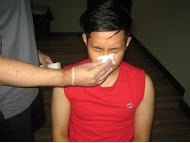Nosebleeds or epistaxis are caused by dryness of the nasal lining and rubbing and picking of the nose when it becomes blocked or itchy. Vigorous blowing of the nose can also cause bleeding.
People with nasal allergies are susceptible to nosebleeds due to constant rubbing and blowing of the nose. Sometimes, nosebleed that does not stop easily can be a symptom of a serious underlying condition. There are two types of nosebleeds – anterior nosebleed which is caused by the breakage of the small vessels of blood in the front area of the nose and usually common in teenagers and posterior nosebleed is caused by some underlying condition and usually common in adults and the elderly. People with high blood pressure can also experience nosebleeds.
Causes of nosebleeds in teenagers

Nasal membranes become dry due to dry air which can result to crusting inside the nasal membranes. These crusting when picked can cause nosebleeds. The bleeding can also be caused by cold, dry climate, excessive heated indoor air, excessive cold climate, allergies and using medications that are snorted.
Some serious causes of nosebleeds include blood clotting disorders, leukemia, internal bleeding caused by injuries, chronic illnesses, nasal tumors and blood vessels that form abnormally. These can result to frequent nosebleeds in teenagers and warrants medical help immediately.
Treatment
- Stop the bleeding by leaning forward and spit out any blood. Sit up and lean forward to avoid swallowing the blood. A basin should be ready if drainage of blood from the throat. Avoid swallowing blood to prevent irritation on the stomach that can result to nausea or vomiting.
- Squeeze the soft part of the nose and apply pressure. The individual should blow his/her nose to eliminate any clots that interferes with the application of pressure. Pinch tightly the soft parts of the nose against the center wall for at least 10 minutes and during this process, breathe through the mouth.
- Wrap ice cubes that serves as an ice pack with a towel and place it over the nose.
If there is still bleeding, use vasoconstrictor nose drops and squeeze again. Another alternative is to insert a gauze and cover it using vasoconstrictor nose drops or petroleum jelly into the nostril and squeeze again for at least 10 minutes. If bleeding persists, seek medical help immediately.
Tips
- Avoid blowing the nose to prevent the condition from worsening.
- Avoid stuffing tissues or any object inside the nostrils
- Use a salt water nasal spray and apply petroleum jelly around the front area of the nostrils to keep the inside part of the nose moist.
- Install a portable humidifier or vaporizer inside the house.
- Trim nails regularly to lessen the chances of injuring the inside part of the nose.
- Wear protective gear when playing sports
